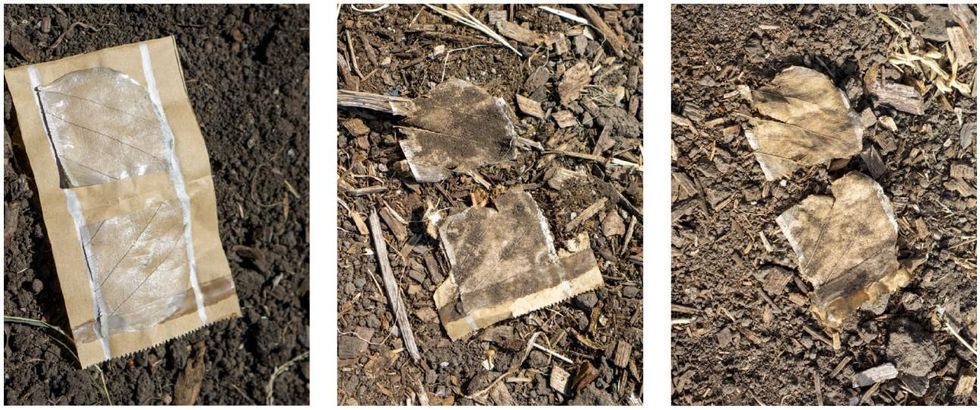Wireless Heater Made From a Leaf Skeleton Is Fully Biodegradable

We've gotten very, very good at making things that are cheap and durable. Unfortunately, there are some deleterious side effects. Among them: Our society generates massive amounts of waste that is going to remain in landfills for a long time. What's more, the process of making these goods is also bad for the environment, considering raw materials, refining, supply chain, packaging, and so on. It's horrendous, if you think about it, which is why most of us tend not to think about it. Realistically, making everything eco-friendly isn't practical, but making some things eco-friendly is-even for a very strict definition of eco-friendly that takes the availability of raw materials, reusability, and eventual disposal into account.
Researchers from the University of California, Berkeley, and Accenture Labs are putting this idea to the test with the design of a wireless heater that can warm up whatever's placed inside of it when the heater is placed on a standard wireless charging pad. This recyclable heater, made from paper, bits of shellfish, silver nanowires, and leaf skeletons, can warm a batch of cookies to 70 C, but will degrade into compost in just a few months.
We believe that there exists a space of semi-permanent" technological design that biological, decomposable materials are well-suited for... If we prioritize the decomposability of materials in our design, can we design interfaces that are durable and have enhanced functionality without sacrificing the convenience of responsible disposability? -Katherine W. Song et al.
A quick word about things that are biodegradable": The words biodegradable," compostable," and ecological buzzwords don't actually have meanings that are all that consistent (or useful) when applied to commercial products. The issue is that while some things might technically have the capacity to degrade under natural conditions, that process may require very specific conditions or might take so much time that it's not practical for most end users. For the Berkeley-Accenture project, the researchers use the terms decomposable" and backyard-degradable" to emphasize that this thing really will turn into dirt in a matter of months if you bury it in your yard.

The framework for the heater is the skeleton of a fig leaf. The researchers chose that because it provides a fine branching structure to distribute heat across a wide area. While you can skeletonize leaves by yourself without much trouble, you can also just buy the preprocessed version on Amazon, because of course you can. Each leaf skeleton is coated with a chitosan gel, which is a polymer derived from discarded shellfish pieces like shrimp shells. The coating keeps the skeleton stable. The denuded leaf skeleton is then dipped into silver nanowires, also purchasable off the shelf. The final step is attaching a couple of leaves onto a kraft paper bag with paper tape, and wiring them together with nontoxic, conductive silver ink. Drawing a silver antenna so the device can receive power wirelessly completes the packaging. Nontoxic thermochromic pigment can be added as a temperature indicator.
That copper coil you see in the video isn't backyard-degradable, but it's a stand-in for a coil printed with silver ink, which is an existing technology that the researchers just weren't focusing on for the purposes of this project. Remarkably, the thing that takes the longest to degrade is the leaf itself, but it should complete its transformation into dirt in about a year.
 Left: packaging before being buried in soil on day 1. Middle: packaging dug up after 15 days. Right: packaging dug up after 30 days.
Left: packaging before being buried in soil on day 1. Middle: packaging dug up after 15 days. Right: packaging dug up after 30 days.
A heating envelope like this can be used in numerous ways. The researchers were able to successfully warm up a chocolate chip cookie and a stroopwafel to the point of ideal gooeyness. And if that isn't enough (it totally should be), they also suggest that their heater could be used to do things like pasteurize milk or juice, warm up wax strips, activate shape-changing elements, and even activate thermally expanding foam to create an envelope that could generate customized protection for whatever is inside. And phones with bidirectional charging could make these heaters easy to use wherever you happen to be.
Our argument is only that through the novel usage of selected decomposable materials, limited but useful electronic technologies can be designed and put into operation." -Katherine W. Song et al.
If some of these applications seem wasteful, don't worry, because all of the materials are cheap, more or less readily available, straightforward to assemble, and will return themselves to nature in a harmless way in just a couple of months. This really requires a shift in thinking about what waste is, and what wasteful really means-the heater presented here shows that it's possible to prioritize natural and backyard-degradable materials and structures in the design of at least some products, a design and manufacturing philosophy that offers a unique application space, and perhaps an entirely new category of semipermanent electronics that we can use and discard guilt-free.
Towards Decomposable Interactive Systems: Design of a Backyard-Degradable Wireless Heating Interface," by Katherine W. Song, Aditi Maheshwari, Eric M. Gallo, Andreea Danielescu, and Eric Paulos, was presented at CHI 2022.